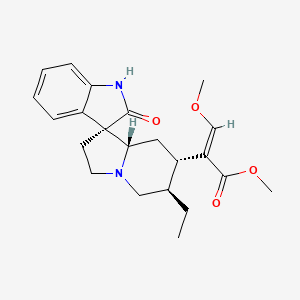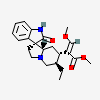Rhynchophylline
- Rhynchophylline
- 76-66-4
- Rhyncophylline
- Rhynchophyllin
- Mitrinermine
- Create:2005-06-24
- Modify:2025-01-18

- isorhynchophylline
- isorhyncophylline
- rhynchophylline
- rhyncophylline
- rhyncophylline, (16E)-isomer
- rhyncophylline, (16E,20alpha)-isomer
- Rhynchophylline
- 76-66-4
- Rhyncophylline
- Rhynchophyllin
- Mitrinermine
- Rhynocophylline
- Mitrinermin
- UNII-46BQ79VJ8D
- 46BQ79VJ8D
- NSC 21731
- CHEMBL519266
- CHEBI:70069
- DTXSID70878612
- NSC-21731
- C22H28N2O4
- Corynoxan-16-carboxylic acid, 16,17-didehydro-17-methoxy-2-oxo-, methyl ester, (7-beta,16E,20-alpha)-
- methyl (E)-2-[(3R,6'R,7'S,8'aS)-6'-ethyl-2-oxospiro[1H-indole-3,1'-3,5,6,7,8,8a-hexahydro-2H-indolizine]-7'-yl]-3-methoxyprop-2-enoate
- Isorhychophylline
- Spiro[3H-indole-3,1'(5'H)-indolizine]-7'-acetic acid,6'-ethyl-1,2,2',3',6',7',8',8'a-octahydro-a-(methoxymethylene)-2-oxo-,methyl ester, (aE,1'R,6'R,7'S,8'aS)-
- MFCD00221748
- 39032-61-6
- Rhynchophylline (Standard)
- RHYNCHOPHYLLINE [MI]
- SCHEMBL2047380
- HY-N0387R
- DAXYUDFNWXHGBE-KAXDATADSA-N
- DTXCID001016656
- HMS3887A03
- HY-N0387
- BDBM50251393
- s9400
- AKOS037514819
- CCG-268460
- CS-3807
- 1ST159052
- R0105
- C09236
- Q7321711
- RHYNCHOPHYLLINE (CONSTITUENT OF CAT'S CLAW)
- RHYNCHOPHYLLINE (CONSTITUENT OF CAT'S CLAW) [DSC]
- CORYNOXAN-16-CARBOXYLIC ACID, 16,17-DIDEHYDRO-17-METHOXY-2-OXO-, METHYL ESTER, (7.BETA.,16E,20.ALPHA.)
- CORYNOXAN-16-CARBOXYLIC ACID, 16,17-DIDEHYDRO-17-METHOXY-2-OXO-, METHYL ESTER, (7beta,16E,20alpha)
- Rel-methyl (E)-2-((3R,6'R,7'S,8a'S)-6'-ethyl-2-oxo-2',3',6',7',8',8a'-hexahydro-5'H-spiro[indoline-3,1'-indolizin]-7'-yl)-3-methoxyacrylate
385.21164 999
160.07512 147
353.18512 61
269.1651 54
385.26944 28
385.21179 999
385.26895 32
353.18842 5
385.14636 5
407.19638492370484 100
416.35738477344296 5.54
240.16210651283856 2.25
417.3602209794348 1.80
230.12380016828826 1.36
160.0785214014522 100
385.22028476245066 87.93
110.09740825450932 19.76
269.16994711366453 17.22
353.19061785226745 14.50

P264, P270, P301+P316, P321, P330, P405, and P501
(The corresponding statement to each P-code can be found at the GHS Classification page.)
Patents are available for this chemical structure:
https://patentscope.wipo.int/search/en/result.jsf?inchikey=DAXYUDFNWXHGBE-KAXDATADSA-N
- CAS Common ChemistryLICENSEThe data from CAS Common Chemistry is provided under a CC-BY-NC 4.0 license, unless otherwise stated.https://creativecommons.org/licenses/by-nc/4.0/Rhynchophyllinehttps://commonchemistry.cas.org/detail?cas_rn=76-66-4
- ChemIDplusChemIDplus Chemical Information Classificationhttps://pubchem.ncbi.nlm.nih.gov/source/ChemIDplus
- EPA DSSToxRhynchophyllinehttps://comptox.epa.gov/dashboard/DTXSID70878612CompTox Chemicals Dashboard Chemical Listshttps://comptox.epa.gov/dashboard/chemical-lists/
- European Chemicals Agency (ECHA)LICENSEUse of the information, documents and data from the ECHA website is subject to the terms and conditions of this Legal Notice, and subject to other binding limitations provided for under applicable law, the information, documents and data made available on the ECHA website may be reproduced, distributed and/or used, totally or in part, for non-commercial purposes provided that ECHA is acknowledged as the source: "Source: European Chemicals Agency, http://echa.europa.eu/". Such acknowledgement must be included in each copy of the material. ECHA permits and encourages organisations and individuals to create links to the ECHA website under the following cumulative conditions: Links can only be made to webpages that provide a link to the Legal Notice page.https://echa.europa.eu/web/guest/legal-notice[No public or meaningful name is available]https://echa.europa.eu/substance-information/-/substanceinfo/100.208.612
- FDA Global Substance Registration System (GSRS)LICENSEUnless otherwise noted, the contents of the FDA website (www.fda.gov), both text and graphics, are not copyrighted. They are in the public domain and may be republished, reprinted and otherwise used freely by anyone without the need to obtain permission from FDA. Credit to the U.S. Food and Drug Administration as the source is appreciated but not required.https://www.fda.gov/about-fda/about-website/website-policies#linking
- ChEBIRhynchophyllinehttps://www.ebi.ac.uk/chebi/searchId.do?chebiId=CHEBI:70069
- LOTUS - the natural products occurrence databaseLICENSEThe code for LOTUS is released under the GNU General Public License v3.0.https://lotus.nprod.net/Rhynchophyllinehttps://www.wikidata.org/wiki/Q7321711LOTUS Treehttps://lotus.naturalproducts.net/
- ChEMBLLICENSEAccess to the web interface of ChEMBL is made under the EBI's Terms of Use (http://www.ebi.ac.uk/Information/termsofuse.html). The ChEMBL data is made available on a Creative Commons Attribution-Share Alike 3.0 Unported License (http://creativecommons.org/licenses/by-sa/3.0/).http://www.ebi.ac.uk/Information/termsofuse.htmlChEMBL Protein Target Treehttps://www.ebi.ac.uk/chembl/g/#browse/targets
- Comparative Toxicogenomics Database (CTD)LICENSEIt is to be used only for research and educational purposes. Any reproduction or use for commercial purpose is prohibited without the prior express written permission of NC State University.http://ctdbase.org/about/legal.jsprhyncophyllinehttps://ctdbase.org/detail.go?type=chem&acc=C052714
- DailyMed
- KEGGLICENSEAcademic users may freely use the KEGG website. Non-academic use of KEGG generally requires a commercial licensehttps://www.kegg.jp/kegg/legal.html
- Natural Product Activity and Species Source (NPASS)Rhynchophyllinehttps://bidd.group/NPASS/compound.php?compoundID=NPC63210
- MassBank Europe
- MassBank of North America (MoNA)LICENSEThe content of the MoNA database is licensed under CC BY 4.0.https://mona.fiehnlab.ucdavis.edu/documentation/license
- Metabolomics Workbench
- SpectraBaseRynchophyllinehttps://spectrabase.com/spectrum/8Z2fr7IYU3y
- Springer Nature
- The Cambridge Structural Database
- Thieme ChemistryLICENSEThe Thieme Chemistry contribution within PubChem is provided under a CC-BY-NC-ND 4.0 license, unless otherwise stated.https://creativecommons.org/licenses/by-nc-nd/4.0/
- Wikidatarhynchophyllinehttps://www.wikidata.org/wiki/Q7321711
- WikipediaRhynchophyllinehttps://en.wikipedia.org/wiki/Rhynchophylline
- PubChem
- Medical Subject Headings (MeSH)LICENSEWorks produced by the U.S. government are not subject to copyright protection in the United States. Any such works found on National Library of Medicine (NLM) Web sites may be freely used or reproduced without permission in the U.S.https://www.nlm.nih.gov/copyright.htmlrhyncophyllinehttps://www.ncbi.nlm.nih.gov/mesh/67052714
- GHS Classification (UNECE)GHS Classification Treehttp://www.unece.org/trans/danger/publi/ghs/ghs_welcome_e.html
- MolGenieMolGenie Organic Chemistry Ontologyhttps://github.com/MolGenie/ontology/
- PATENTSCOPE (WIPO)SID 394581877https://pubchem.ncbi.nlm.nih.gov/substance/394581877





